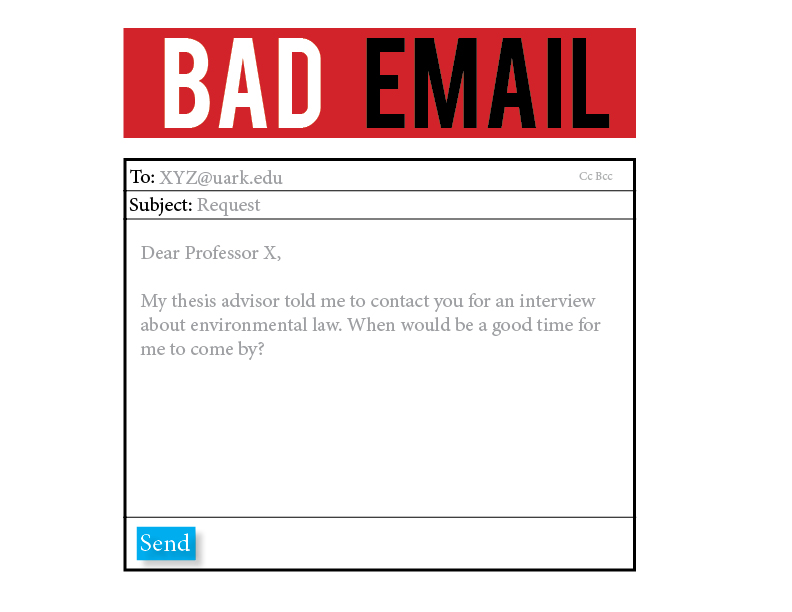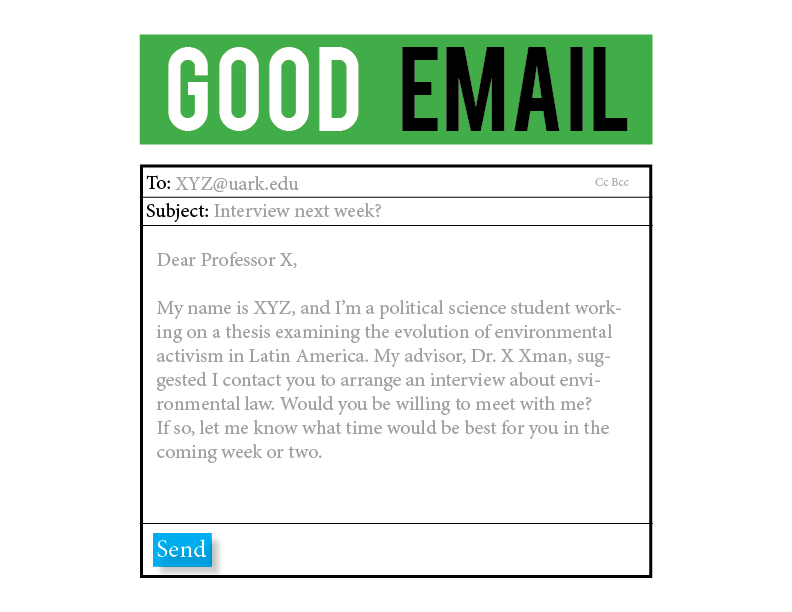At the busiest times of my semester, I receive fifteen to twenty emails per day. One of my professors, Dr. Tricia Starks, estimates that anywhere from two to three hundred messages arrive in her inbox daily; and for department heads or administrators, the numbers can be even higher – [former] Vice Provost Sharon Gaber places the number at over one hundred… by 8 a.m.! When it comes to emailing your professors: think succinct! Here are some pointers on composing solid, short messages.
1. Subject lines are always important. Be as descriptive and brief as possible:
Bad subject line: Request
Good subject line: Letter of recommendation by June 5?
See the difference? The good subject line is crisp yet informative – your recipients can tell instantly what’s needed and when. The bad subject line is just too vague.
2. Make sure you’re getting your titles right. When you email a professor, “Professor ______” is usually a safe bet no matter the gender, rank, or position of the person in question. You can also use “Dr. ___” and their last name. Don’t use first names – it’s best to err on the side of formality when emailing professors and administrators.
3. Keep it concise. When I began emailing regularly, I’d try to cram as much relevant information as possible into a message, thinking this approach would be more convenient for the recipient by saying everything that needed to be said all at once. Not so. Emails with multiple requests/action items tend to sink to the bottom of busy peoples’ inboxes and malinger there, unanswered. Keep your emails short and limit them to a single issue.
4. Be aware of your tone. All sorts of nuances dictate how an email should be composed, and it’s easy to get overwhelmed with questions: Is this word appropriate? Should I use contractions? How do I seem comfortable without coming across as arrogant, or respectful without being overly deferential? The best answer to these questions, in my experience, is to maintain constant awareness of the tone you’re employing. This will vary depending on the type of message you are sending, as well as to whom you’re sending it. For starters, you’ll never have a reason to be less than fully professional the first time you email someone. For instance: 
This isn’t necessarily rude, but it’s a tad informal for what seems to be a first-time communication – and you need to ask whether the professor has time to meet with you. Spruce it up a bit to include a short introduction and more polished wording: 
After you’ve built a rapport with the person you’re emailing, more casual communication will likely become acceptable if not advisable. Take it on a case-by-case basis.
5. Be sparing and strategic with text lingo and emoticons. It doesn’t take long to figure out that a proliferation of LOLs and TTYLs isn’t wise to include in emails, but every so often, a dash of informality can artfully defuse what could otherwise turn into a sticky situation. For instance: “Dear Professor X: While reviewing our grant paperwork, I noticed that we still seem to be missing your recommendation letter – no rush, but I wanted to remind you of the April 15 deadline just in case you’d forgotten during this busy time of the year : ) Thanks again! XYZ” Though it may seem a bit hokey, the value of such an inclusion is clear – it would be difficult for anyone to read the above message as pushy.
6. Always include a thank-you. It may sound intuitive when thinking about emailing professors, employers and the like, but you’d be surprised how easy it can be, when shooting off messages one after the other, to forget a simple concluding thank-you.
7. Think carefully before sending an email when frustrated or upset. I can’t stress it enough: emails are forever. Down the line, you don’t want to regret pressing send on anything you’ve written emotionally. If you’re bothered by something and feel it needs to be addressed, by all means, draft your email – but don’t send it until your head has cleared and you’ve had a night to think it over.
8. Before hitting “send,” proofread. Typos reflect poorly on you and some have the potential to embarrass. That’s why it’s always essential to give your subject line and message a quick read before you send it.


A professor friend advises: “Remember to sign your name or provide it in the message. We can’t always figure it out from the email address anymore. Students should include the class that they’re enrolled in because we teach multiple courses with different formats of delivery and deadlines.” Thanks for the tip!